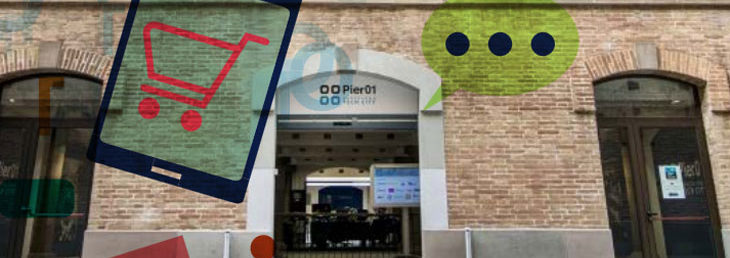
10 Jul Co-Session #32 (II): We visited Sónar +D the day after talking about Millennials and Generation Z
In our Co-Session #32 we wanted to reflect on these two generations that share having lived all or most of their lives in a digital and hyperconnected world. And we did it hosted in Pier 01 by Barcelona Tech City, a private non-profit association that has turned this building in the port of the city into a hub and an accelerator for technological start-ups that has also become a benchmark for the local and international technological ecosystem based in Barcelona.
A case of collaboration: Payment Innovation Hub
Given the space that hosted this session and our vocation for collaboration cases, it was essential for us to include a presentation about the Payment Innovation Hub.CEO Silvana Churruca gave us details about this consortium made up of very diverse partners: VISA, Samsung, banking institution CaixaBank, provider of financial technology services through payment GlobalPayments, and vehicle leasing company Arval. These companies have created a working group focused on the future of electronic payments. From the beginning, they wanted a team that was multidisciplinary, flexible and, above all, completely new—none of the members has previously worked in the partner companies.
With a philosophy of open innovation inside and outside of the hub itself, their team works for the companies with the aim of facing the opportunities and challenges in the field of electronic payments with new technological capacities, new regulatory frameworks, market and consumer trends or new factors. The space where we had our Co-Session usually hosts collaboration and co-creation activities with their members and the community in the hub’s ecosystem. These activities may be simply aimed towards networking or sharing knowledge, but in a more advanced phase of ideation they can also go from designing a new product or service to creating a minimum viable product.
Getting to know Pier 01: start-ups tour by Barcelona City Tech
Before having lunch, we had the chance of getting to know a little bit better both the building and the organization that was welcoming us. We had a guided tour through the facilities at Pier 01, a building measuring over 11.000 m2 that hosts around 1.000 people and more than 100 companies, mainly start-ups. Pier 01 is one of the most important projects from Barcelona Tech City, an initiative driven by local entrepreneurs whose objectives include promoting Barcelona in the international marketplace as a tech brand and an attractive city for entrepreneurs.
Miquel Martí, CEO of Barcelona Tech City, defined Pier 01 as “a miracle” resulting from having overcome the trouble of getting many people to agree. Today this miracle takes the form of co-working spaces, showrooms and common areas designed to promote innovation and cooperation, as well as an ambitious program of activities, talks and workshops. The tour allowed us to interact with part of the innovation and entrepreneurial ecosystem that Pier 01 accommodates: start-ups like Capital Cell (equity crowdfunding), but also service companies such as Ikomobi, which specializes in connected user experiences, or venture builders like Antai, which has undertaken more than 14 digital businesses since 2012.
How do Generation Z use social media?
It was precisely another one of the companies located in Pier 01, BeAgency, who allowed us to finish the day looking into the peculiarities of the so-called Generation Z. BeAgency is a MAO (mobile phone, audiovisual and omnichannel) advertising company. That is, they specialize in this target audience. “Gen Z teenagers represent a very wide and diverse group. Only 40 % of them identify as members of a generation”, explained Alexia Herms, Head of Digital at BeAgency.
Despite this diversity, BeAgency knows the different factors that distinguish them when interacting with contents and brands. Generation Z were born with a phone in their hand. That’s why they communicate “vertically” and through photos and video, rather than through words. They are more active on social media than their predecessors, and less inclined to do so in a passive way. They interact more with brands, co-creating new products or contents with them, for instance. But this doesn’t mean that they’re more loyal to brands. They are drawn to what is ephemeral, which can translate either into a greater ability to change from one product to another, or a way of consuming contents mostly “on the go”. They are self-taught thanks to YouTube, a video platform that also hosts their referents—celebrities are now being replaced by YouTubers. Through the mistakes Millennials made, they have learnt to be more conscious about their digital reputation.
The Co-Session continued the next day: we visited Sónar +D
This Co-Session was extended until the next morning to take the opportunity of seeing the beginning of Sónar D+, an international conference about creativity, technology and business held at the same time as the popular festival of advanced music. Since 2013, Sónar +D brings together in Barcelona artists, creative technologists, musicians, filmmakers, designers, scientists, entrepreneurs, makers, hackers and all types of audiences from 130 countries with the aim of learning and experimenting with technology.
This is exactly what we tried to do during the few hours that lasted our guided visit. We got to learn about very diverse and innovative projects, such as a workshop to build a nanosatellite; a talk by the Long Now Foundation, an association that fosters thinking about the future of humanity in 10.000 years’ time, and an initiative that wants to send music to a potentially habitable planet 12,5 light-years away from the Earth. We learnt about the Sónar +D Innovation Challenge 2018 and the challenges that different companies looking for creative solutions proposed this year to the creative community of the festival. We moved to the rhythm of the music composed by Google’s Machine Learning. And we finished our visit at the light and sound immersive space created by scientific and artistic project Zero Gravity Band. In anticipation of humanity’s future space exploration, they are studying the sensorial and aesthetic perception in zero-gravity environments.



Sorry, the comment form is closed at this time.